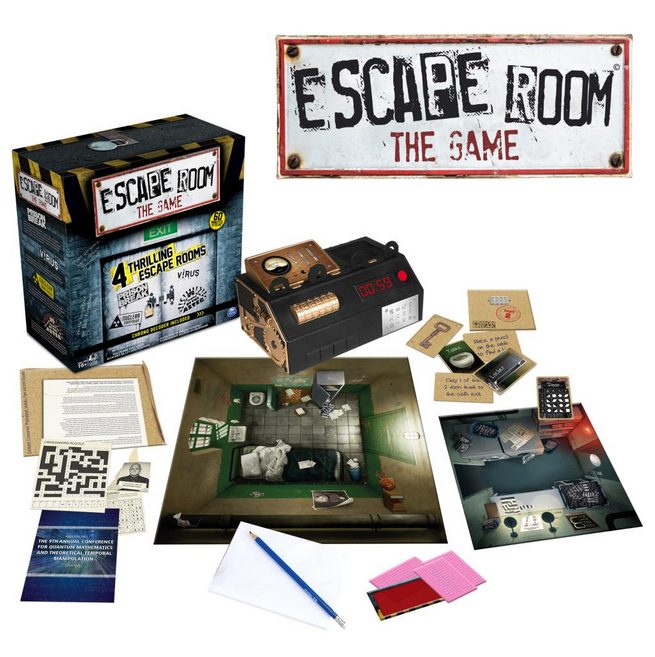Who will become the best Guild Master? Upgrade your guild hall and recruit skilled adventurers so you can complete contracts for fame and fortune.
What Is Guild Master?
Guild Master is a game for 2 to 4 players, ages 14 and up, and takes about 1 to 2 hours to play. It has a few days left on Kickstarter, with a pledge level of $49 for a copy of the game. The game does have some complexity, so I think the age rating is about right, though you might be able to skew a little younger with experienced gamer kids.
New to Kickstarter? Check out our crowdfunding primer, and visit our Kickstarter curated page for more projects we love.

Guild Master Components
Note: My review is based on a prototype copy, so it is subject to change and may not reflect final component quality. In addition, stretch goals may add some more components to the game.
- Game board
- 4 sets of player components:
- Order board
- Guild Upgrade board
- Guild screen
- 13 Order cards
- Fame marker
- Contest token
- Round marker
- Builder Cost marker
- 64 Coin tokens (in denominations of 1, 2, 5, and 20)
- 95 Contract cards:
- 35 Common Contract cards
- 30 Heroic Contract cards
- 30 Legendary Contract cards
- 56 Adventurer Cards:
- 20 Novice Adventurer cards
- 18 Adept Adventurer cards
- 12 Hero Adventurer cards
- 6 Legend Adventurer cards
- 24 Small Upgrade tokens
- 15 Large Upgrade tokens
- 6 Prestige tokens
- 30 dice
There’s definitely a lot packed into the box. The prototype was quite nice and felt almost production quality, so it gave me a good sense of what the final may be like.
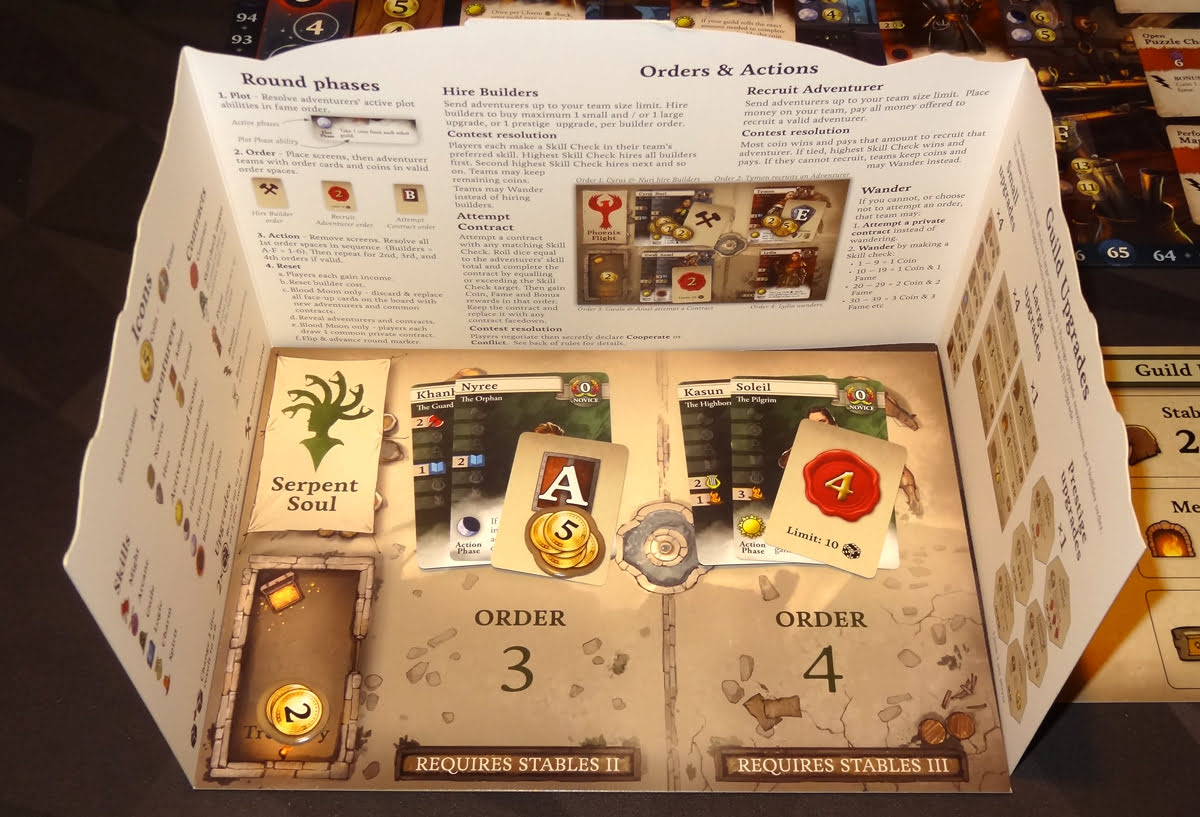
The guild screens are made to look like the guild hall exterior, and they’re quite tall, made to fit exactly around the order boards so you can hide your actions as you’re planning. The inside of the screen serves as a player aid, too.

The coin tokens are nicely illustrated, made to look like single coins, a pair of coins, and five coins; the 20-coin token is a gold bar. The board and adventurer cards also look great, with a diverse cast of characters and a nice background that doesn’t distract too much from the cards.
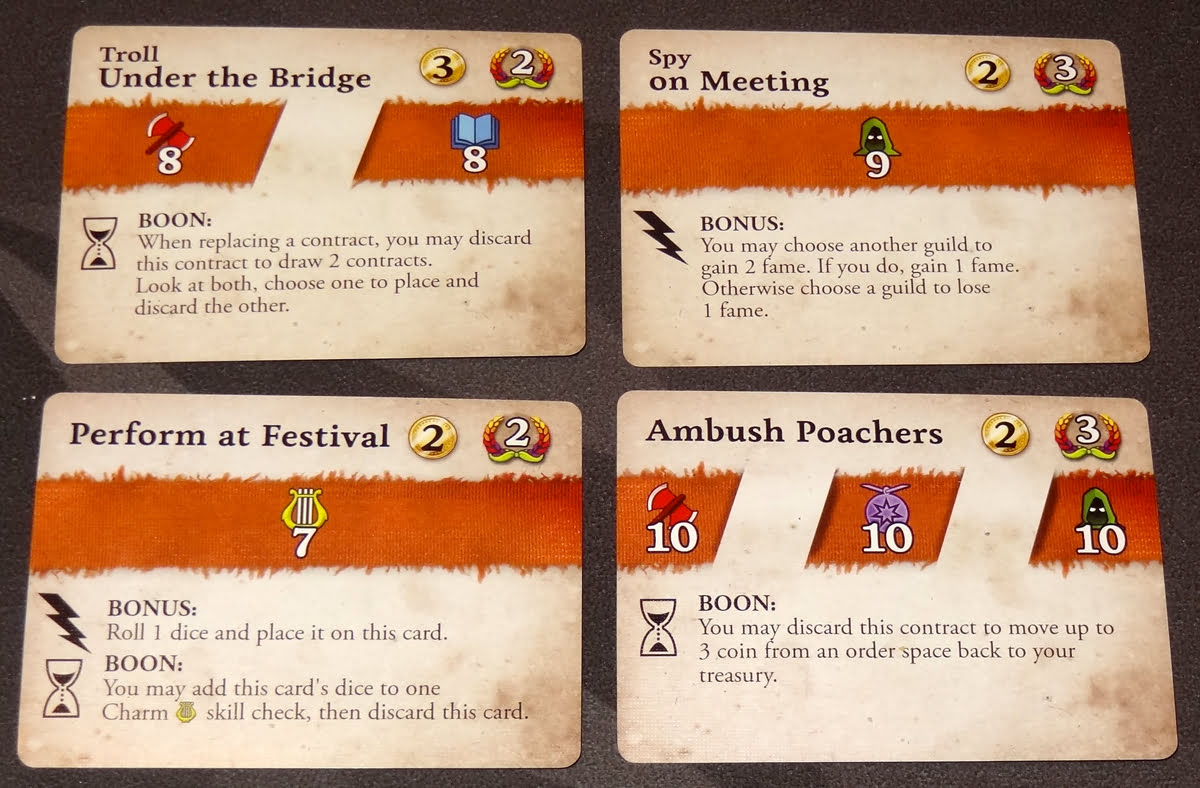
We didn’t have any trouble understanding the iconography on the cards, either, with character powers, contract bonuses, and global event effects. The adventurers and contracts all have evocative titles, though there isn’t any flavor text. I liked the contract names, and you could get a sense of the story just by the types of skills required. As much as I like fun flavor text in games, I also appreciated that the cards were clear and easy to interpret without being too busy.
I only had a few complaints about the components. One is that the fame markers are small cardboard pennants that are placed next to the score track, printed around the edge of the board. Because the scoring track is a bit too small to put the tokens on the scoring track, they sit next to the board, where it’s very easy to bump them as you’re picking up money or cards, refilling the decks, etc. I’d much rather have a slightly wider scoring track so that they can sit on the board itself.

[Edited and updated]: The starting novice adventurers are divided into teams of four, with certain teams available based on the player count. My prototype did not have any easy way to sort them, but the final version will have sorting icons so that it’s a bit easier to place them into teams for setup.
Overall, though, the components look great and worked well.
How to Play Guild Master
You can download a copy of the rulebook here, as well as print and play files if you’d like to try it out for yourself.
The Goal
The goal of the game is to score the most fame in 9 rounds by hiring adventurers, building upgrades, and fulfilling contracts.

Setup
Set out the main game board in the center of the table, placing the upgrade tiles, three contract decks, dice, and coins nearby. The adventurer decks will be placed on the various spaces on the board itself, with the exact number of each type determined by the number of players. The round tracker is placed on Round 1 with the half-moon side showing, and the builder cost marker is placed at the bottom of the track (in the space corresponding to the player count).
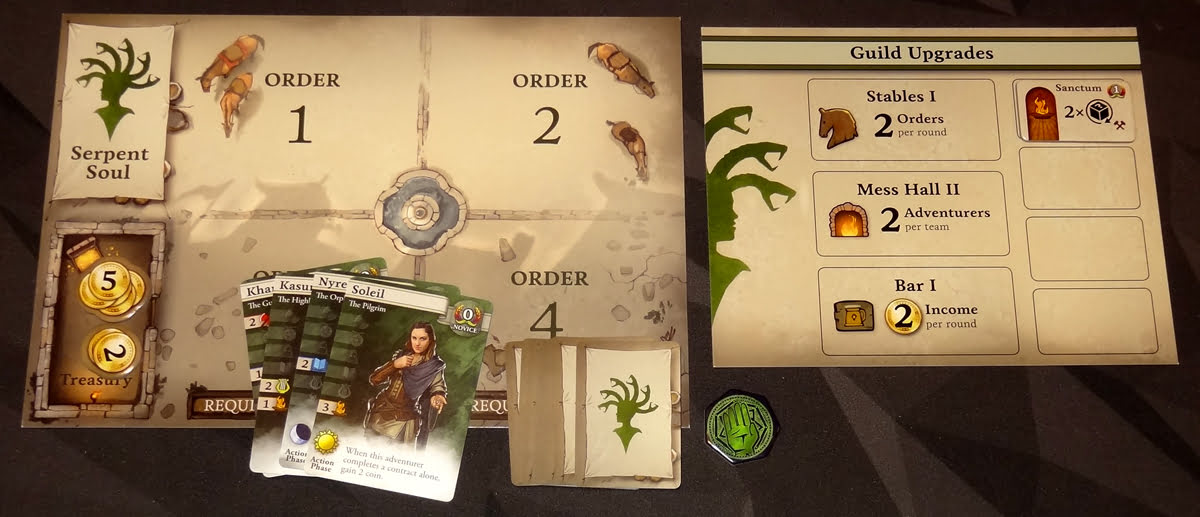
Each player receives a set of player components: an order board, guild upgrade board, screen, contest token, and the 13 order cards. The fame token goes near the board at the “0” space of the scoring track. Each player also receives a team of four novices and a guild upgrade—the teams used will vary based on the number of players. You may choose which side of the upgrade tile to use: it gives you either two rerolls or the ability to change a die to a “6” for a particular skill.
Deal each player 5 contracts from the common contracts deck. Each player chooses one to place face-down on the board in the contracts section, one to keep as a private contract, and the rest are shuffled back into the deck.

Gameplay
Each of the nine rounds has four phases: Plot, Order, Action, Reset.
At the beginning of blood moon phases, players also get to draw a private contract from the common deck, if available. Also, check the face-up contracts for events that may affect the round.

The plot phase is when certain adventurers’ abilities take effect. Adventurer abilities will have an icon and a phase printed next to it, indicating which moon phase (half, full, or blood) the ability may be used. A sun icon means that it can be used in any round. Every round, the round tracker token is advanced and flipped over, so it switches between half moon and full moon. In addition, every third round is a blood moon (in addition to half or full, whichever is showing). Players activate their plot phase powers starting with the player with the most fame (points).

The order phase is a programming phase. Behind your screen, you organize your adventurers into teams and place them into spots on your order board, along with the order card that represents what action they will take, and any coins you will want to spend on that action. The order cards indicate whether you will hire builders, recruit a specific adventurer from the board, or attempt a specific contract from the board. At the beginning of the game, you are limited to 2 orders (which can be increased by upgrading your stables) and 2 adventurers per team (which can be increased by upgrading your mess hall).
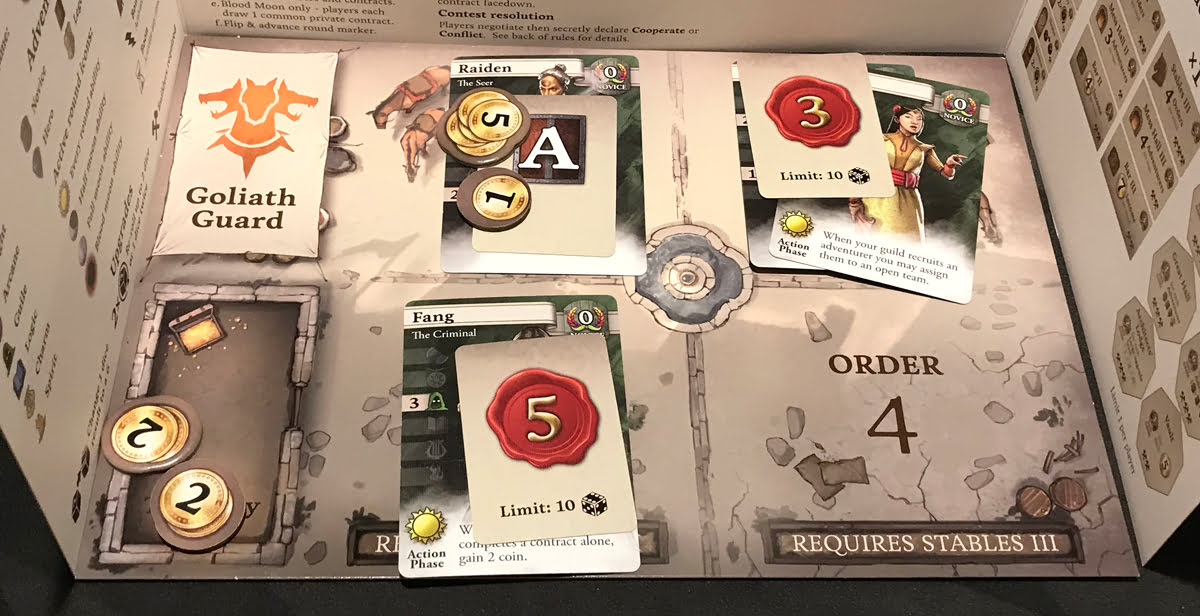
Once everyone has finished setting up their teams and orders, the screens are removed and order boards are revealed.
During the action phase, players will resolve their orders. Everyone resolves Order 1, then everyone resolves Order 2, and so on. Within each order, you resolve builders, then recruiting (from A to F), and then contracts (from 1 to 6). If two players chose the same action, then you have to resolve the tie to see who gets to take the action first. Teams may also wander, either because they choose not to take the chosen action or because their desired action was taken by another player.

Hiring Builders
Hiring builders requires spending coin, and the builder cost moves up for each builder that’s hired, which means that building later in the round can get quite expensive. You may build a small upgrade and a large upgrade in the same round, or one prestige upgrade—each one is marked with a number of hammer icons that indicates how many builders are required to build it. Small upgrades improve a particular skill for your adventurers; large upgrades increase your order capacity, team capacity, or income; prestige upgrades are worth end-game points if you meet their requirements. Gain fame points for small or large upgrades as shown on the tiles.

In case of a tie for builders, the teams will do a skill check—choose a skill for your team, and roll dice equal to the total value for that skill. The higher total roll gets to hire builders first.
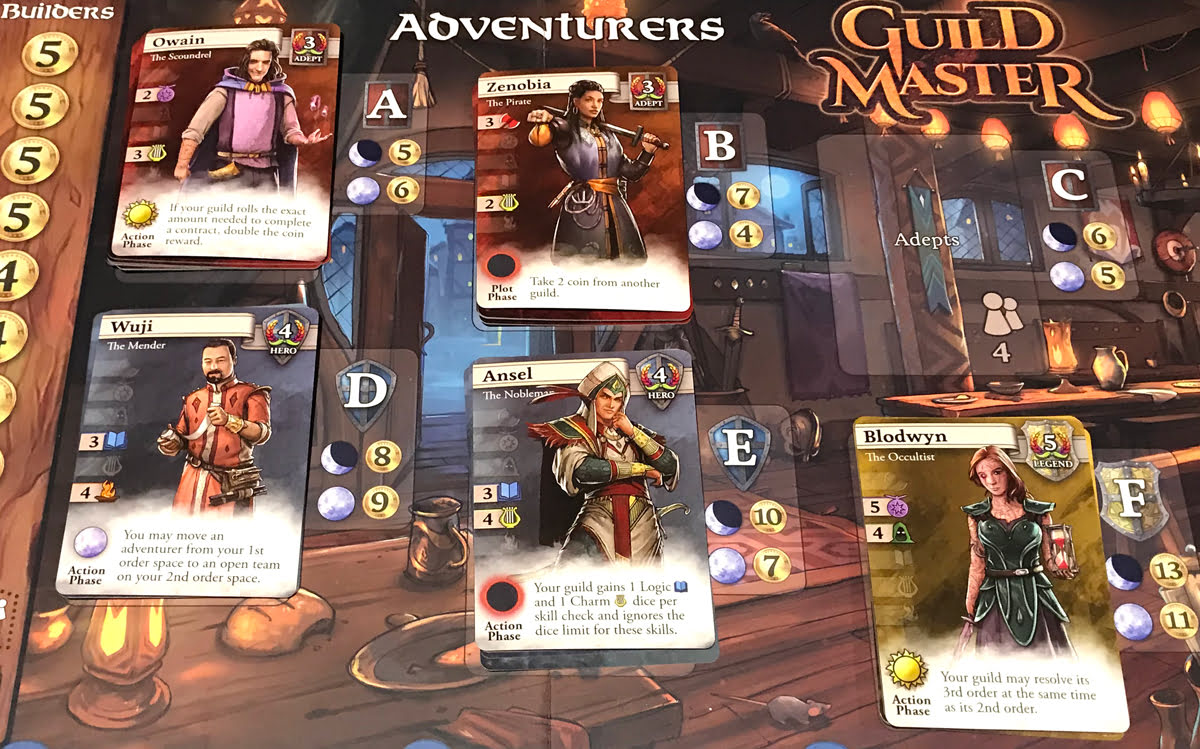
Recruiting Adventurers
Each adventurer slot has a minimum cost shown on the board, and it varies depending on whether it’s half moon or full moon round. The adventurers on the board are ranked as adepts, heroes, and legends. Anyone may hire an adept, but you must have at least one adept in your guild to hire a hero, and at least one hero in your guild to hire a legend. You may put any amount of coins on your order space (at least the minimum cost), but you must spend the entire amount if you hire the adventurer. If there’s a conflict because two people want to hire the same adventurer, the player with the higher bid wins. (And if there’s a tied bid, then you do a skill check.) The adventurer is placed into your guild (not in an order space), but the next adventurer is not revealed until the reset phase. Gain fame points shown on the new adventurer.
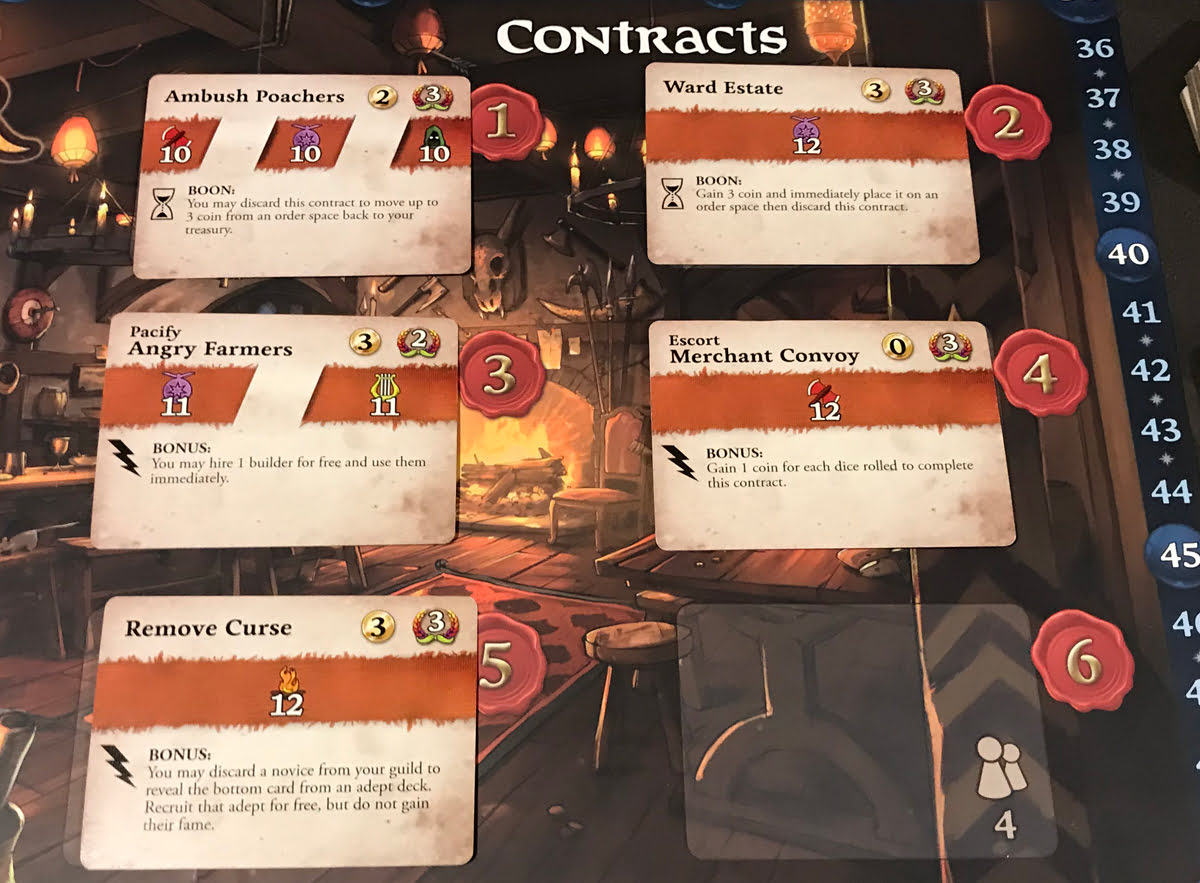
Completing Contracts
To complete a contract, you must do a skill check matching one of the printed requirements. You add up your skill value for a matching skill across the team that is attempting the contract, and roll that many dice. You must meet or exceed the value shown on the contract. You gain fame and coin as shown at the top of the contract. In addition, there may be bonus effects printed on the contract—a lightning bolt indicates an immediate effect, and an hourglass indicates that you may discard the contract for its effect later.
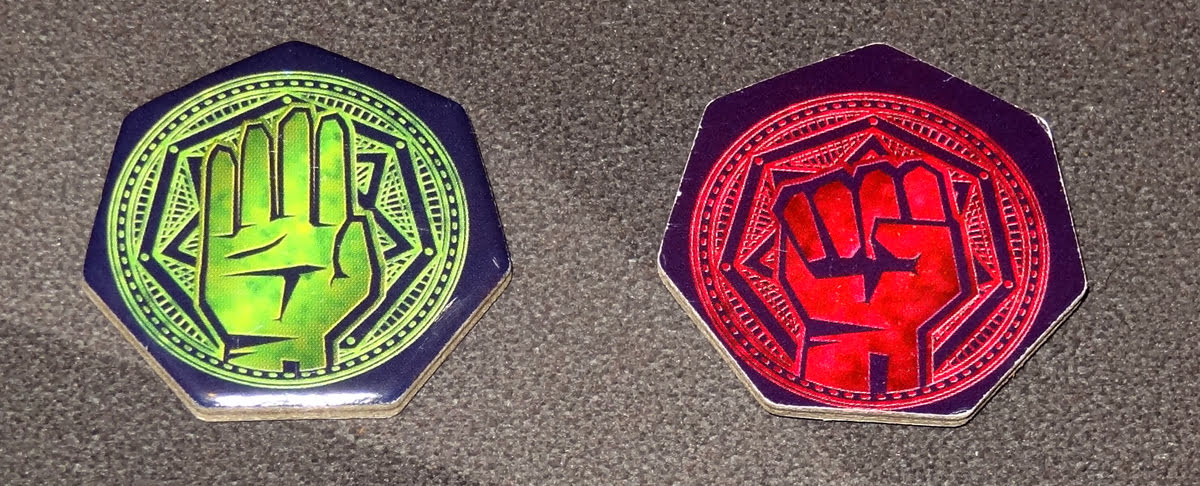
If multiple players go after the same contract in the same order, they must choose whether to cooperate or compete. There’s a period of negotiation, where players may decide how they would want to split the coin, the contract card itself, and any bonus effects for completing the contract. Then, everyone secretly uses their contest token to indicate cooperate or compete, and reveals simultaneously.
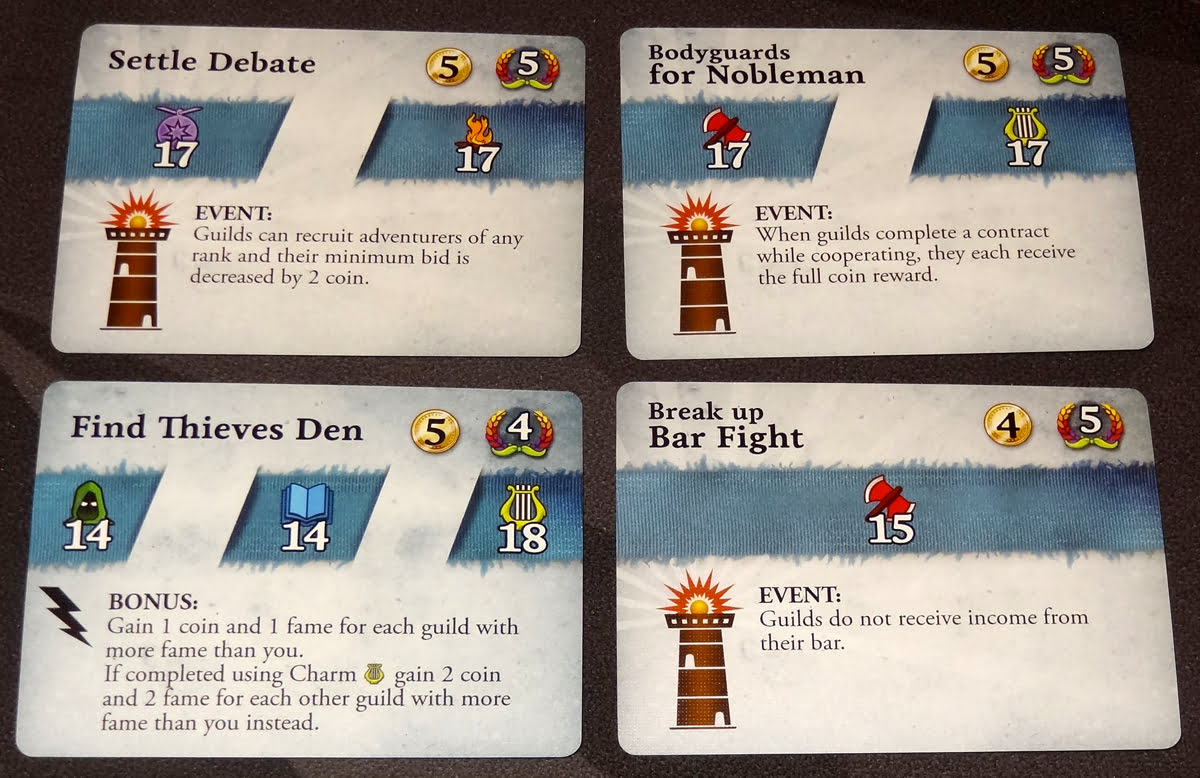
If everyone cooperates, players may build a team together to attempt the contract. Everyone gets the full fame reward, but then the rest of the benefits are divvied up as negotiated. If only one player competes, they get to attempt the contract first, but with a penalty that makes it harder. If more than one player competes, then the cooperating players get to try it first, and if they fail then the competing players may attempt it with the penalty (with the higher roll taking the contract).
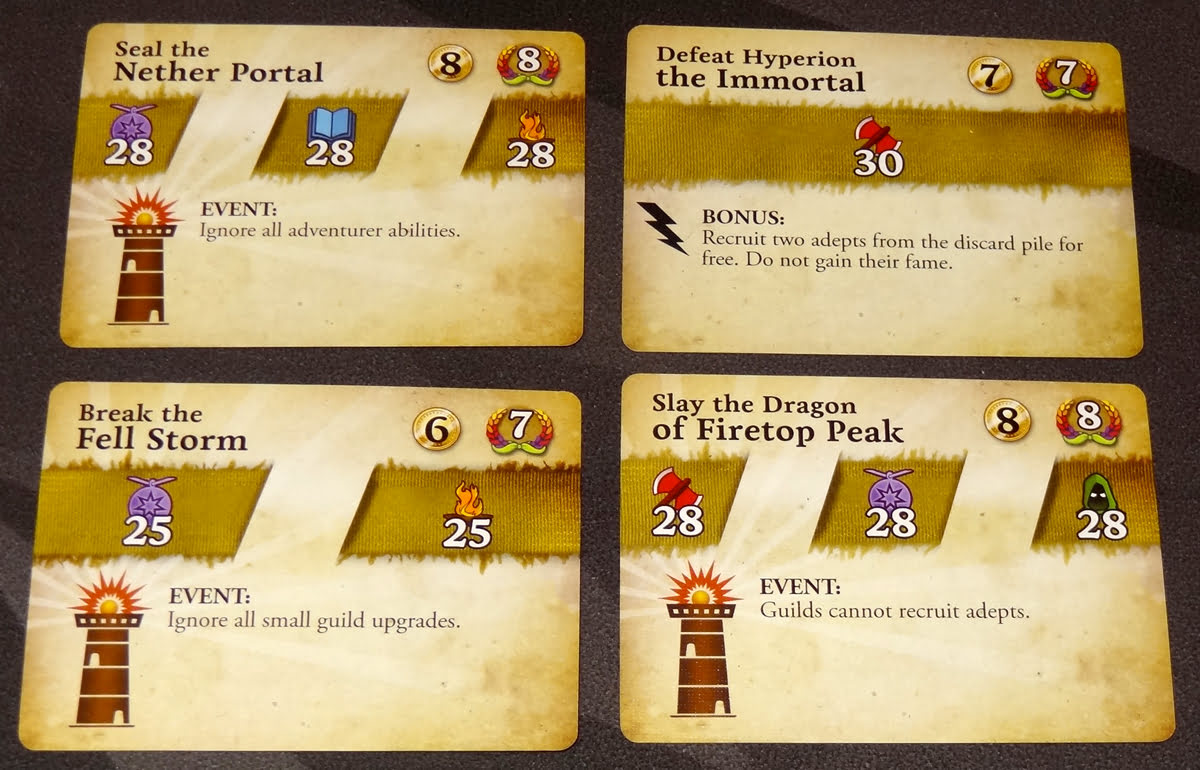
Whoever completes the contract then draws a new contract from any of the three decks and places it face-down in that space.
Wandering
Sometimes you won’t be able to complete an order that you chose because it’s no longer available (for instance, if you get outbid on an adventurer or somebody completed the contract on an earlier order). In those cases, you may wander to get a little extra coin and fame. Roll a skill check for your wandering team. For every multiple of 10 (rounded down), you get 1 fame and 1 coin. If you roll less than 10, you just get 1 coin. Or, you may use a wandering team to attempt one of your private contracts.
After all orders have been resolved, you reset for the next round. If it’s a blood moon round, you discard all face-up adventurers and contracts, and fill in contracts from the lowest ranked cards available. The builder cost is reset, and adventurers and contracts are turned face-up to refill. Everyone earns income according to their bar upgrade. All adventurers, order cards, and coins are cleared from your order board.
Then the round marker is flipped over and advanced.
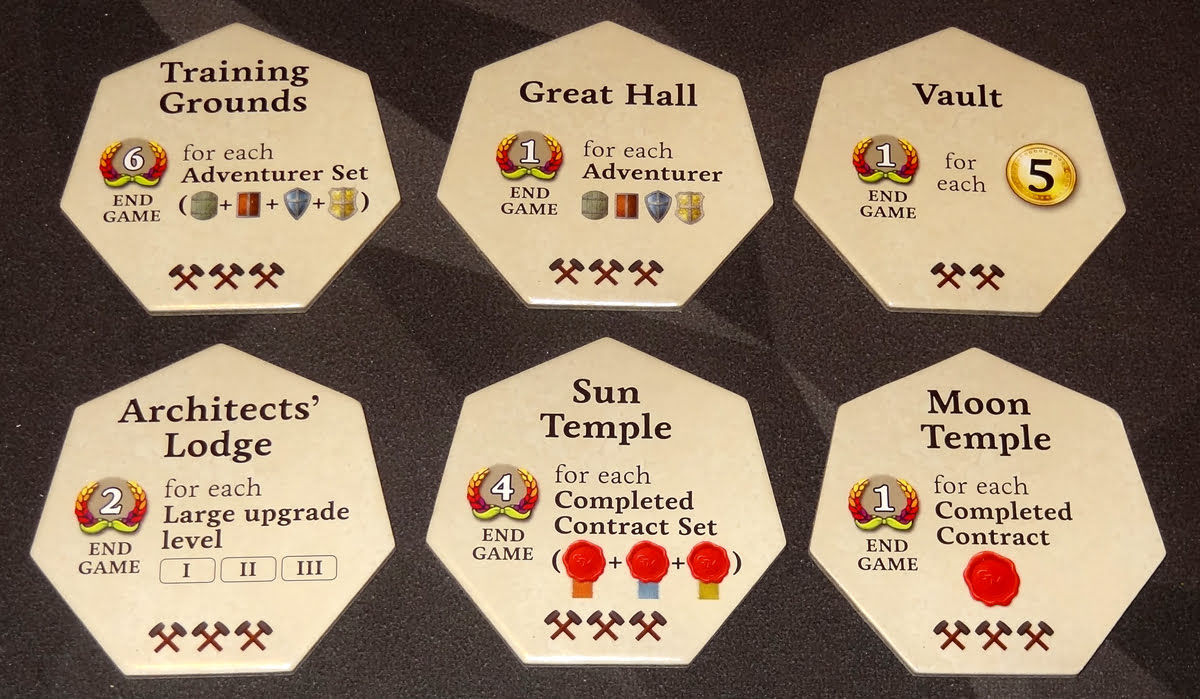
Game End
The game ends at the end of round 9. Players will get 1 fame point for every 5 coins, plus any fame points earned for prestige upgrades. The highest score wins.
Negotiation
Many things in the game can be negotiated: you’re allowed to trade favors in terms of card effects and plot phase powers, if you want to pay somebody to use an effect on you or somebody else, and so on.
Why You Should Play Guild Master
Normally, I like to post Kickstarter game reviews on the launch date, but unfortunately I wasn’t able to get a prototype of Guild Master to try out until just last week, so admittedly this review is a bit of a hot take and is coming in at the last minute. I saw a demo at the Good Games booth at Gen Con, and was intrigued enough that I agreed to give it a shot despite knowing that the timing would be pretty tight. And although I’ve only gotten to play once so far, I enjoyed it and am excited to try it again (and maybe redeem my last-place score).
Guild Master does an excellent job of making you feel like you’re running a guild, starting with a handful of novices and working your way up into the big leagues. Want to expand your stables so you send your adventurers to more places? Better catch those builders early in the month, before they get swamped and the prices go up. There are skilled adventurers hanging out in the tavern, but if you’re too slow (or too stingy) then they might get hired away by another guild. And those lucrative contracts will bring your guild fame and income … but only if you manage to complete them.
There are a number of ways that your plans can be foiled—somebody else acts sooner than you, or is more skilled than you, or you didn’t allocate enough money. Or, sometimes, it’s your own fault because you didn’t bring a good enough team for the job and they fail to complete a mission. I really enjoyed the programming aspect of the game, trying to figure out what your opponents are up to and which of your actions you should take first in case there are others interested in the same things.

I like the way that the adventurer powers may trigger on different rounds, because it adds another wrinkle to the way you assemble your teams. Legend adventurers have the most powerful abilities, of course, and they can be used every round—but it will take you some time to build up to the level where you can even hire a legend for your guild. Do you try to max out a few of the skills, so you can go after legendary contracts for big rewards, or do you diversify and have a little of each, so you can tackle any type of contracts but will probably need to stick to the common contracts?
With only one play so far, it’s hard to know what approach works best, but that’s another thing that I really enjoyed about Guild Master: it feels like there are many ways to go about building up your guild. For instance, if you wanted to attempt harder contracts, you could hire better adventurers, or build up your stables so that you can just send more adventurers at one time, and then hire more adepts rather than trying to splurge on heroes and legends.
I also really liked the events that pop up on the contracts—it’s a great way to add in game-changing effects without having a separate event deck, and it can drive players to attempt specific contracts to get rid of negative effects. For instance, the “Seal the Nether Portal” contract shuts down all adventurer abilities, which felt pretty drastic, so two of us went after it at the same time, hoping to fix the problem and score some big points while we were at it. (Spoiler alert: we failed.)
It is a fairly long game—our 3-player learning game took us about 2 hours, so I imagine the 2-hour estimated time will be about right for experienced 4-player games. Even so, it didn’t feel too long as we were playing, and one player even said he would have liked three more rounds, because once you’ve got your guilds built up you’d really like to see some of those powers go into effect. That’s true of many engine-building games. Once you’ve built your engine, you want to see how well it runs.
Overall, I had a good time playing Guild Master and look forward to playing it again in the future. For the most part, I found the rules usually made intuitive sense because they matched the theme pretty well and the iconography was easy to interpret. I think the most confusing part was when players conflicted on a contract, knowing the outcomes based on how many players cooperated or competed. It really does a nice job playing out the theme and I like the mix of programming moves and looking for card synergies.
For more information or to make a pledge, visit the Guild Master Kickstarter page! But don’t wait too long—the campaign ends this Thursday, September 20.
Click here to see all our tabletop game reviews.
![]() To subscribe to GeekDad’s tabletop gaming coverage, please copy this link and add it to your RSS reader.
To subscribe to GeekDad’s tabletop gaming coverage, please copy this link and add it to your RSS reader.
Disclosure: GeekDad received a copy of this game for review purposes.




